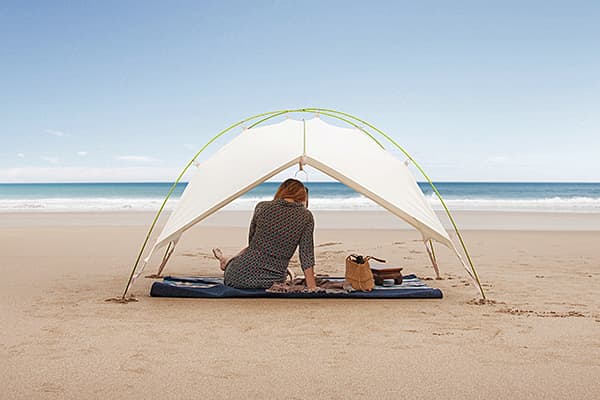We feel our beach canopies are perfect sun-safe protection from the sun’s harmful rays but naturally we encourage you to wear sunscreen for a great day at the beach as well. To understand how sun protection is measured, what to look for in a sunscreen, and how to apply it… read on.
How SPF Came to Be
The concept of SPF was first developed in the 1970s by a group of scientists at the University of California, San Francisco. The scientists were looking for a way to measure the effectiveness of sunscreens in preventing sunburn. They developed a test that involved exposing human volunteers to artificial UV radiation and measuring how long it took for them to develop a sunburn. The scientists then calculated the SPF as the ratio of the amount of time it took for the skin to burn with sunscreen to the amount of time it took for the skin to burn without sunscreen.
The SPF test was first published in the journal “Archives of Dermatology” in 1974. The test quickly became the standard way to measure the effectiveness of sunscreens. In 1978, the Food and Drug Administration (FDA) began requiring sunscreens to be labeled with their SPF.
Today, SPF is one of the most important factors to consider when choosing a sunscreen. SPF helps to protect the skin from sunburn, premature skin aging, and skin cancer. It is important to choose a sunscreen with an SPF of 30 or higher and to reapply it every two hours, or more often if you are swimming or sweating.
Sunscreen protection factor (SPF) is a measure of how well a sunscreen protects the skin from ultraviolet (UV) radiation. UV radiation can cause sunburn, premature skin aging, and skin cancer. SPF is a logarithmic scale, so an SPF of 30 blocks 97% of UVB rays, while an SPF of 50 blocks 98% of UVB rays.
SPF is measured by applying sunscreen to the skin of human volunteers and measuring how long it takes for them to develop a sunburn when exposed to artificial UV radiation. The SPF is then calculated as the ratio of the amount of time it takes for the skin to burn with sunscreen to the amount of time it takes for the skin to burn without sunscreen.
SPF does not measure protection from UVA rays, which also contribute to skin cancer and premature skin aging. UVA rays penetrate the skin more deeply than UVB rays, so they are more difficult to block. Most sunscreens offer some protection from UVA rays, but it is important to choose a sunscreen that specifically states that it provides broad-spectrum protection.
SPF is not a measure of how long you can stay in the sun without getting burned. Sunscreen should be reapplied every two hours, or more often if you are swimming or sweating.
Tips for Choosing a Sunscreen
When choosing a sunscreen, there are a few things to keep in mind:
* SPF: Choose a sunscreen with an SPF of 30 or higher.
* Broad-spectrum protection: Choose a sunscreen that provides broad-spectrum protection, meaning it protects from both UVB and UVA rays.
* Water resistance: Choose a sunscreen that is water resistant if you will be swimming or sweating.
* Fragrance-free: Choose a fragrance-free sunscreen if you have sensitive skin.
How to Apply Sunscreen
Sunscreen should be applied liberally to all exposed skin 20 minutes before going outside. It should be reapplied every two hours, or more often if you are swimming or sweating.
Here are some tips for applying sunscreen:
* Apply sunscreen to all exposed skin, including the face, ears, neck, and hands.
* Be sure to reapply sunscreen every two hours, or more often if you are swimming or sweating.
* Use a broad-spectrum sunscreen that provides protection from both UVB and UVA rays.
* Choose a sunscreen that is water-resistant if you will be swimming or sweating.
* If you have sensitive skin, choose a fragrance-free sunscreen.
By following these tips, you can help protect your skin from the sun’s harmful rays. Naturally, we also recommend a beach tent or canopy as direct protection from harmful rays. Check out our newly released “The Crescent” for an easy-to-carry portable option.




